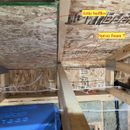Attic baffles
Hi there,
Building in northern Canada, ventilated attic.
The framer did his own baffles made of plywood, however he installed baffles every 4 rafter and blocked the other cavities with plywood.
• Is this bad? should I do remove the ply wood and installed some pre-made baffles?
• if no, should I try to insulate the cavities with spray foam ( I got a couple of froth pak lying around) – I think it would be best if no cold air goes through the middle (or side) of the loose insulation, but only comes via the baffles.
Here is a picture.
Thanks
GBA Detail Library
A collection of one thousand construction details organized by climate and house part










Replies
You need vent channels under the entire underside of the roof sheathing, not every some-number-of-rafters. You can leave the vent baffles made of OSB in place, there's nothing wrong with site built baffles. You can then add factory baffles, or site built baffles, into the other rafter bays. You don't really need spray foam here, even if you want a conditioned attic, since you could insulate under those baffles with just about anything -- the ventilation provided by the vent channels eliminates most moisture concerns.
I would probably seal those gaps between the baffles and the OSB at the end of the rafter bays with a bit of canned foam. You don't need anything fancy like a Froth Pak, regular Great Stuff will be fine. You don't need a perfect air seal, you just want enough to keep insulation from getting into the vent channel, and sometimes it's helpful to limit the ability for insects to get through too.
Bill
Thanks Bill for the advice. I followed your directions, got some Durovent baffles, stapled them and use can foam around. Will be much better.
One other thing I should probably mention: make sure the ends of those baffles tie into whatever vent space exists within the soffit so that there is a path for air to freely flow from the intake soffit vents up into the vent channels over the baffles. I've seen people place things in such a way that the vent path in the soffits is obstructed, which greatly reduces the effectiveness of the ventilation system as a whole.
Bill